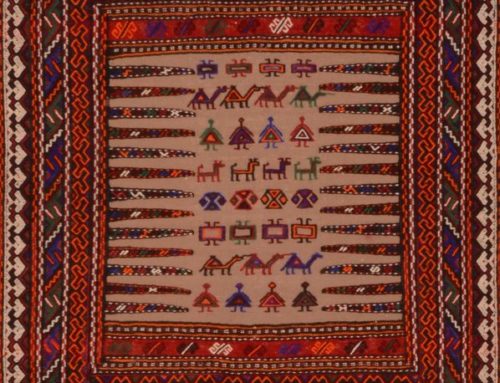Baluch rugs are traditional tribal rugs made in Baluchistan, on the eastern border of Iran. They are also in the bordering areas of western Pakistan and south west of Afghanistan. Baluch rugs often have geometric motifs and tribal designs. Initially, they were made for tribal tents. Hence, Baluch rugs come in small sizes. They can make very fine entrance rug and are appropriate for small spaces. They would fit very nicely in a traditional or minimalist setting. Please note there are several variations in the spelling: Balochi, Baluch, Baluchi and etc, but they all refer to the same rug style.
The Baluchi Tribe
Baluch rugs are hand-knotted area rugs weaved by a large tribe with a common lifestyle, geography, and background. The Baluchi tribe includes Kurdish, Turkish, Persian, Charaymagh, Afghanistan and Sistani nomadic people. Because of the nomadic nature of this tribe, you will find Baluch rugs that are from Iran, Afghanistan, Turkey and the surrounding regions. It is essential to mention that each region adds its own signature in different aspects to the rug. This can vary from the colors and patterns used. This can cause some difficulty in identifying the city it was weaving in. However, local people involved in making Balochi rugs would be able to easily tell you the origin of a Baluch rug.
Unique Characteristics
Weave and Production
In the Iranian side of Baluchistan, a huge amount of material is used to make these rugs. In fact, more than 5,000 tons of wool and 200 tons of silk and enormous amounts of natural vegetable dye are produced. This production has made a great contribution to the Baluch carpet industry.
Large rugs typically use a vertical and standing loom. Because the size of Baluchi rugs is smaller, the loom is normally horizontal and on the ground. Weavers normally use simple tools that are locally made by the nomadic people. For the wool, generally, they use sheep wool, although some camel wool can be used. For example, the light brown undyed wool is from camel wool.
Design
One of the most distinct features in the Baluchi rugs is that they have a larger section of the rug on both ends that are flat woven. For the flat woven part of the Baluch rugs, they normally use the Somak weave. The flat woven part in these rugs is partially double lined and partially single line in the base of the rug. This gives the rugs a distinct look.
The design pattern of Balochi carpets is geometric. There is hardly ever any circular, round, and floral motifs in these area rugs. The patterns are often repeated throughout the rug. But representations of floral motifs in geometric designs are visible. Among other known designs are prayer rugs in Baluchi weave. They normally have an arch with two Lachak corners on the top.
Color
Popular colors used by Baluchi weavers are:
Dark brown
Dark blue
Navy blue tending towards black
In older Baluchi carpets, purplish brown or brownish purple, are used. Weavers create these colors by using a certain amount of dye with different soleplates. An easily noticeable feature of these area rugs is the use of dark colors. When they use natural undyed camel wool in the background, the carpet is unusually a light color. That lighter brown also may be produced by Hanna or onion skin. In the past, they used natural dying seeds and leaves from different trees. The skin of pomegranate and onion has also been used as dyes.
Sizes
Baluchi rugs are limited to smaller sizes. Some of the most popular sizes are
- 3×5
- 4×6
- 5×7
The most popular shape is rectangular. Other shapes are rare. The Raj, or density, of the Baluch rug, is generally between 25 to 30. This makes about 90-100 knots per square inch. Although not as common, there are some finer weaves that could be as high as 160 knots KPSI.
One must always keep in mind that rug weaving is an art. No matter what the general trend is, one artist may decide to weave a totally different variation of a Baluch rug. Therefore, don’t be surprised if you see a unique Baluchi rug. If you love dark geometric designs and nomadic motifs, Baluch rugs can be a great choice.

